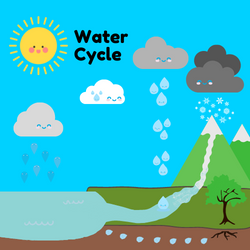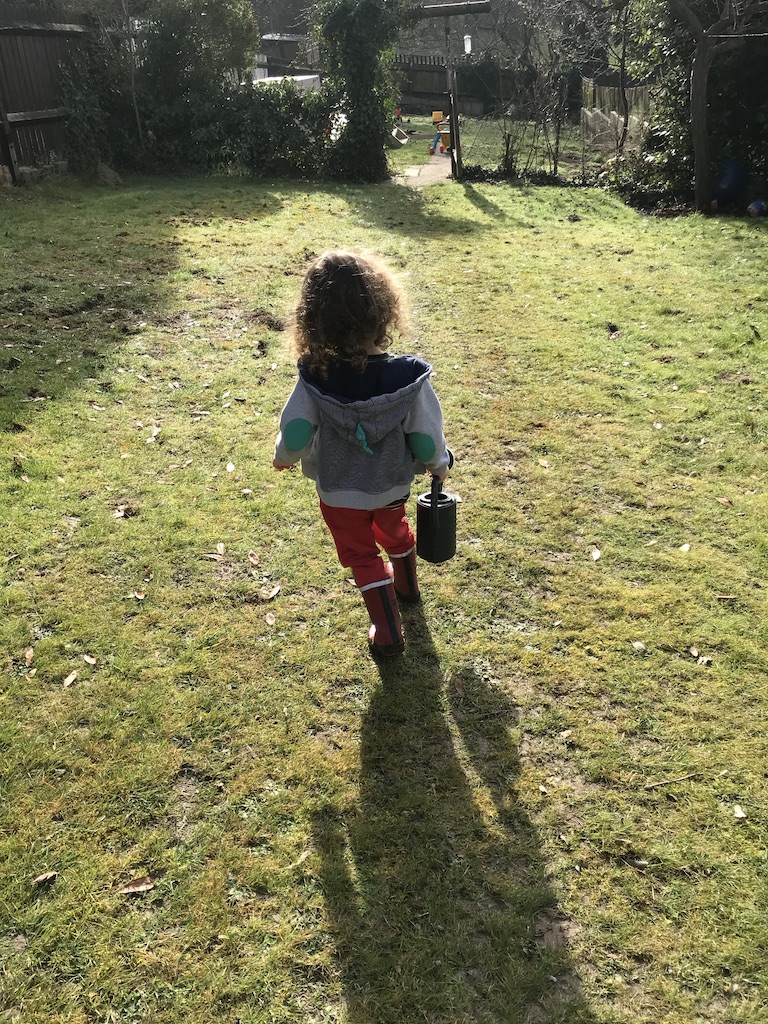Getting young children interested in environmental issues
Water is finite, the amount of water circulating through the earth's water cycle is the same that has been there since it's start, no more, no less.
Only 3% of all the worlds water is fresh, but only 0.5% of that water is available for human use, the rest is frozen in glaciers or is deep within the earth and unreachable.
"If a bucket contained all the world’s water, one teacup of that would be freshwater, and only one teaspoon of that would be available for us to use."
~Dr James Jenkins.

Water Cycle.
The amount of water we each use every day for washing and drinking is overshadowed by our virtual water use, this is the water used in the production of everything we
eat, buy and wear.
In 2018, a person in the UK used on average 149 litres per day for drinking, cooking, laundry, flushing
toilets and other daily physical uses, however 3,400 litres per person per day is needed to produce everything that we consume in a year. The amount of water physically available in London and
the South East is only half that.
As a result the UK imports 75% of its virtual water from other countries, and nearly half of these imports come from countries with unsustainable levels of ‘blue’ or irrigated water use.

Asparagus uses on average 2,150 litres per kilogram. In Peru, irrigation required for the crops caused wells to dry up which was used by a nearby community of 18,000 people.

Avocados use on average 2,000 litres per kilogram. In Chile, irrigation required for the crops caused underground aquifers and rivers to dry up. Villagers nearby now depend on water supplies being trucked-in.

Cotton requires ‘blue’ irrigated water. Large-scale irrigation of cotton crops has shrunk the Aral Sea by 80% since the 1960s. Cotton fabric grown and produced in India uses on average 22,500 litres per kilogram. Due to population growth, changes in diets and consumer habits the world’s water crisis is getting worse.
As more floods and severe droughts occur, changes in water quality and availability will impact the most vulnerable and affect health and food security.
Reducing the amount of water that goes to waste in our homes helps protect the wildlife that lives in rivers and wetlands, as well as cutting the energy needed for treating and pumping water for domestic use. While also thinking about what we buy and where it comes from can help us reduce our water footprint.
Activity Ideas
A study carried out in 2013 found that engaging young children in environmental issues can change the behaviour of their parents and as a
result encourage greater water conservation in the home.
Show your child how water can be saved and reused by using water from a water-butt or leftover water from drinks for the following activities.
Gutters, pipes and drains.
While at home, or out for a walk, look at gutters, pipes and drains. This activity will help your chid thinking about water sources and and how it's affected by pollution.
Questions to ask
- What they do?
- Where does the water go?
- Can you name the different type of water?
- Which are natural, which are man-made?
- Which have salty water and which have fresh water?
- How can we save water?
- Why do we need to save water?
- What are the different uses of water?
Watering the garden
Watering the garden helps your child start to understand life cycles and where food comes from, and gives them a chance develop important motor skills needed when filling and emptying the containers, it also allow them to follow directions related to the position and location of plants.

Caring for plants.
Questions to ask
- Is the watering can full?
- Is the watering can empty?
- How much more water do you need?
- Is the water up to the top?
- How often do we need to water that plant?
- Which plants need more water?
- Why do plants need water?
- How many buckets of water does that plant need?
Collect and measure water
Use a number of different container sizes, funnels and plastic tubes. This activity will help your child remember and analyse information and predict outcomes.
Questions to ask
- Is the container full?
- Is the container empty?
- How much more water do you need?
- How can you make water move?
- What does it look like?
- How can you create big ripples in the water?
- How can you make small ripples?
- What happens to the items in the water when it’s moving?
Floating and sinking experiments
Use a large container filled with water and a number of floating and sinking items. This activity will help your child understand buoyancy and density, how and why things happen, and will encourages them to use their imagination and develops creative thinking.
Questions to ask
- Why do some things float and some things sink?
- Does the weight, size and material of the item influence it's ability to float?
- Why were there bubbles when some items sank?
Other
- Read stories about saving water.
- Make up songs or stories about saving water.
- Talk about World Water Day.